
Fans are an easy, relatively inexpensive way to keep you comfortable when temperatures rise in your home. In this article, we will explain what a fan is, what it actually does, and share tips on maintenance and how to choose the right fan for you.

If you have a specific question in mind, feel free to use the table of contents to skip directly to what you’re looking for.
Fan Basics
When feeling warm, we naturally fan ourselves to direct air toward us. This provides a cooling effect and eases our discomfort. Modern fans come in a variety of types and are more efficient and effective than ever before. Here is some detailed information on fans.
What is a Fan?
Fans range from handheld paper versions to complex whole-house operations that move air throughout a space. Typically these can be used anywhere depending on the type of power they take. Hand-operated fans are less effective but require no power while others need batteries or an electrical outlet to function.
These are the most rudimentary cooling devices and have been adapted to keep many items cool, including computers and vehicles.

How Does a Fan Work?
While we use fans often, what exactly do they do and how do they do it?
Have you ever stuck your hand out the window while the car was moving? You likely experienced a lower temperature hitting your hand than the actual air temperature. This is called the wind chill effect. Fans take advantage of this natural phenomenon to create a cooler environment.
Instinctively, we know that a breeze always feels cooler when the temperature rises. A fan creates a breeze to move stagnant air throughout the room to keep you cooler. When we are hot, our bodies use evaporation in the form of sweat to cool us down. At the same time, we release heat from our bodies into the air. A fan removes that heat and also evaporates our perspiration, leaving us feeling cooler.
Contrary to what most people may believe, fans do not actually cool a space, instead, they cool the occupants within the space. This is why they must continuously run in order to keep you cool. Fans are also great for moving cool air produced by an air conditioner into less ventilated areas.

Types of Fans
There are many types of fans. For this article, we will focus on types of fans capable of cooling your bedroom, tent, or attic.
Ceiling Fans
Ceiling fans are one of the most popular types of fans. This type of fan uses rotating pitched blades to force air upwards or downwards (depending on the season) to move air throughout a room.
Box Fans
A box fan is exactly what it sounds like; a fan within a box-like housing. The front and back are open and covered by a grill to allow air to flow in and out. These are popular for placing in or near windows to facilitate airflow. Which leads to our next type, window fans.

Window Fans
Window fans are specifically designed to fit in a window opening. The window is usually lowered to rest on top of the unit and draws in fresh air from the outside.
Standing Fans
This encompasses several types including tower fans, pedestal fans, and floor fans. These fans sit on the floor and can be positioned anywhere. Many oscillate to direct air in all directions.
Whole House Fans
A whole house fan draws cool air in through the windows or your home while creating pressure in the attic which is then released via vents or soffits. This type can cool your home in a short period of time due to the dual operation of bringing cool air in while simultaneously pushing hot air out the top of your home.
Attic Fans
An attic fan is used primarily to vent hot air out. Since hot air rises, venting the stagnant, heated air allows cooler air to continue circulating and pushing hot air into the attic to be exhausted outside.
Read Before Buying
If you need some cooling in your space but don’t want to go to the expense or hassle of installing an AC, a fan may be a great option. Here’s how to determine which type of fan you need.
What Size of Fan Do I Need?
Fans are sized by the amount of air they can move. This is expressed in a CFM (Cubic Feet Per Minute) rating, which refers to the amount of air a unit can move in a specified period of time.
If using a ceiling fan, take into consideration the length of the blades. Longer blades will direct air to a larger area. Fan blades of 36” or less are best for a room up to 75 square feet. For larger rooms up to 400 square feet, you will need fan blades between 50-54”.
The actual size of a unit is not the ultimate factor though. Many smaller fans can produce a significant amount of air movement. Be sure to consider all factors when making a purchase.

How to Choose a Fan
Other than size, there are factors that can be even more vital when choosing a fan.
Efficiency
A fan that increases your energy bill significantly, can be a deterrent to using it. Be sure to consider how efficiently your fan moves air to be sure the unit you choose will keep you cool and happy.
How the Air Moves
Some fans push air in one direction, while others oscillate to move it in all directions. Ceiling fans push air vertically over a larger space while most other types push air horizontally. Knowing how your fan will move air will help you decide which fits your needs.
Portability
Will you be wiring a fan into a single location as in a ceiling fan? Or do you prefer to easily move the unit to various spots indoors and outdoors as necessary?
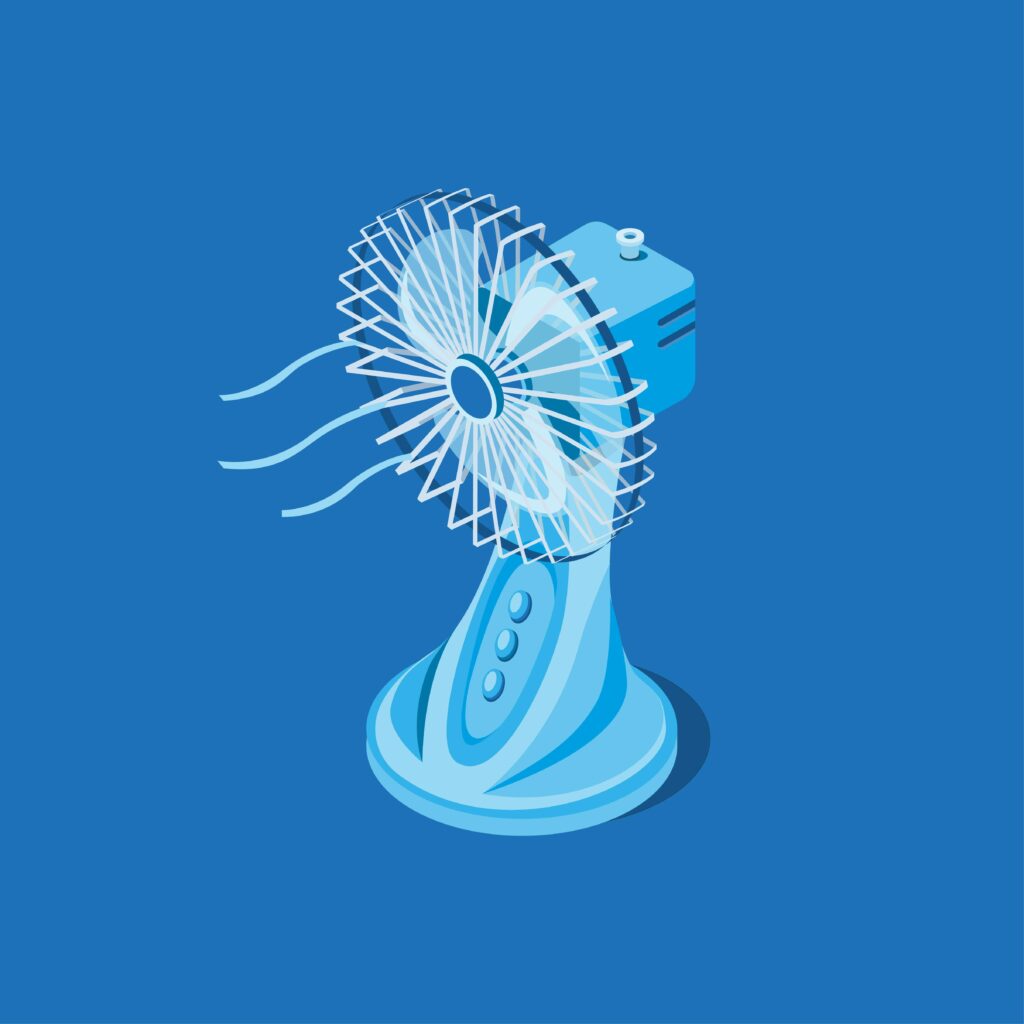
Controls
How much control do you want over the unit? Do you need a remote? Adjustable fan height, speed, direction? Ability to turn oscillation on/off as needed? Consider how much variability you need in a unit.
Filter
Some fans come with a filter that can remove dust and allergens from the air. If this is something that tops your list, be sure to find one with this capability.
Popular Fan Brands
Many companies make fans but not all companies do it as well as others. Some brands put extraordinary focus on innovation and are always coming out on top. Here are some names to consider when purchasing a fan for your home. Click on the links below to go to our full brand reviews.


Ceiling Fan Brands
● Casablanca
● Craftmade
● Emerson
● Hunter
● Kichler
● Minka-Aire
● Monte Carlo
Room Fan Brands
● Dyson
● Honeywell
● Lasko
● Vornado
Fan Maintenance Tips
Fortunately, fan maintenance is pretty easy. Keeping the fan blades clean and oiling the motor are really the only maintenance required. However, there are some issues you may run into.
Common Fan Issues and Troubleshooting
Here are some quick tips to troubleshoot common issues.
Ceiling Fan Issues
My Ceiling Fan Wobbles
If your fan wobbles and looks like it could fall at any moment, there are a few things that could be causing this. First, be sure the unit is installed correctly and there are no loose screws or bent or loose connections. Next, look at the blades. Are any damaged or shorter or longer than the others? Ceiling fan blades must all be exactly the same shape, size, and length from the motor to be effective. Lastly, check the hanger ball at the bottom of your downrod to see if it has been dislodged.

Why Does My Ceiling Fan Make So Much Noise?
Though fans always make some noise, if the noise is louder or new, you may have loose pieces or parts. Another common cause is dirty or unoiled ball bearings. You will likely need to disconnect the unit and remove the cover to access these for cleaning. After cleaning, be sure these are lubricated according to the manufacturer’s instructions.
My Ceiling Fan Won’t Turn On
This is typically an easy fix or a sign you’ll have to get a replacement. The first task is to check the electrical connections to make sure the fan is getting power. First, if the fan has a light, see if the light works. If so, you know the issue isn’t power.
Next, check your circuit breaker. If this is not the problem, be sure the wall switch is in the proper position. Still not working? At this point, the power will have to be turned off for further troubleshooting. Once the power is off to the unit, check for loose wiring or connections. Be sure everything is connected and turn the power on and try again. If none of these worked, you may need to replace the whole thing.
The Lights on My Ceiling Fan Are Flickering
Flickering lights can be caused by a bulb that is going out (easy to fix) or a voltage issue (call an electrician) or a few other things. Try changing the bulb. If the problem persists, check for loose connections. If the flicker happens when using other appliances, you’ll need to call a professional.
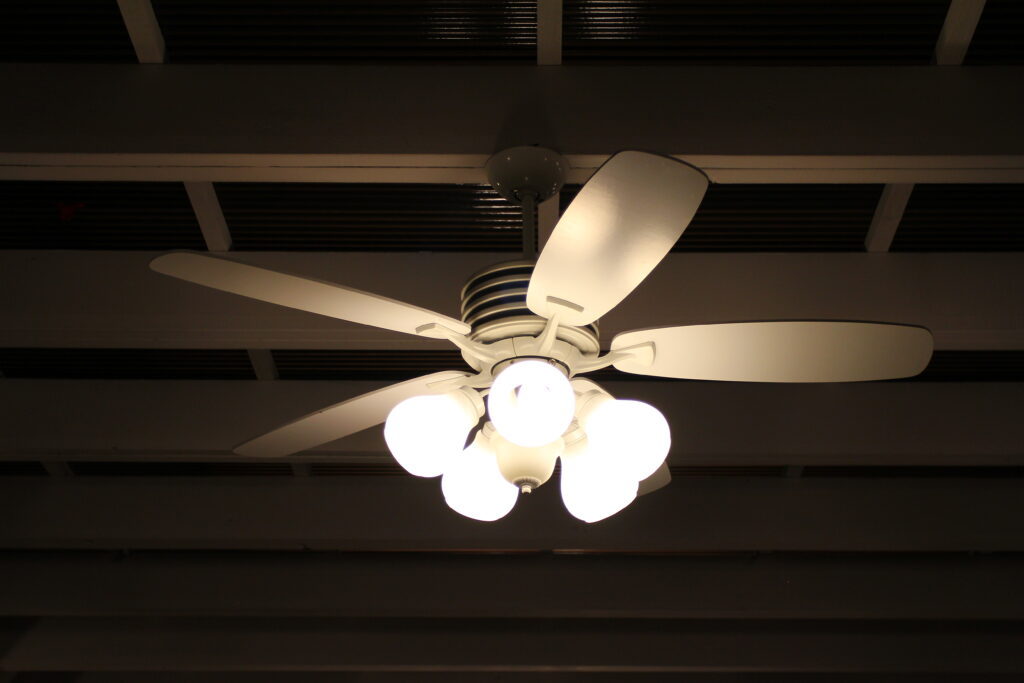
My Fan is Stuck on One Speed
A fan that is stuck on one speed is likely due to a worn-out capacitor. Before you get worked up, check the bearings to be sure they are clean and oiled to see if this solves the problem. If not, you may have to repair or replace the unit.
Room Fan Issues
Fan Not Oscillating or Fan Stopped Working
When a fan doesn’t move the way it should, you need to check the power. Be sure to check the circuit breaker, outlet, cord, and fan fuse. If all these are operating properly, clean and tighten all connections. Then try replacing the cord. Lastly, grease the motor and check for obstructions.
Room fans are fairly inexpensive and don’t have many replaceable parts. If yours isn’t functioning properly after the steps above, you should look at getting a new one.
How to Install a Fan
Installing a room fan simply requires you to determine the proper placement, plug it in, and you will instantly enjoy cooler air. A ceiling fan, on the other hand, is a little trickier. Here is how to install a ceiling fan. This guide is only for homes with existing wiring. If no wiring exists, you will need to start with running power to your ceiling.

1. Always turn off the power at the circuit breaker first.
2. Next, remove any old light or fan fixtures by unscrewing and disconnecting wires.
3. Attach the mounting bracket included in your kit.
4. Cut the wires to desired length, strip the ends of the wires and feed them through the canopy and downrod (if included).
5. Attach the downrod and tighten screws to hold in place.
6. Temporarily hang or have someone hold the fan motor assembly and connect all wiring. Consult your manual for proper wiring instructions. Match wire colors when connecting. Use a wire nut and electrical tape to secure.
7. Tuck wires inside the electrical box and attach the canopy to the ceiling bracket.
8. Attach fan blades. This may be done with screws or levers that lock blades into place.
9. Add light kit if included and attach the cover.
10. Turn on the breaker and flip the electrical switch.
If you need a visual aid, check out the video below. Just push pause between each step, these guys talk fast.
How to Clean a Fan
All fans need to be cleaned regularly. Since they draw indoor air through their blades, they are subject to collecting a plethora of dirt and dust. Here’s how to keep them clean and operational.
Cleaning a Room Fan
For a room fan, all that is required is a wipe down and removal of dust. Here is how to make sure your fan is clean and working great.
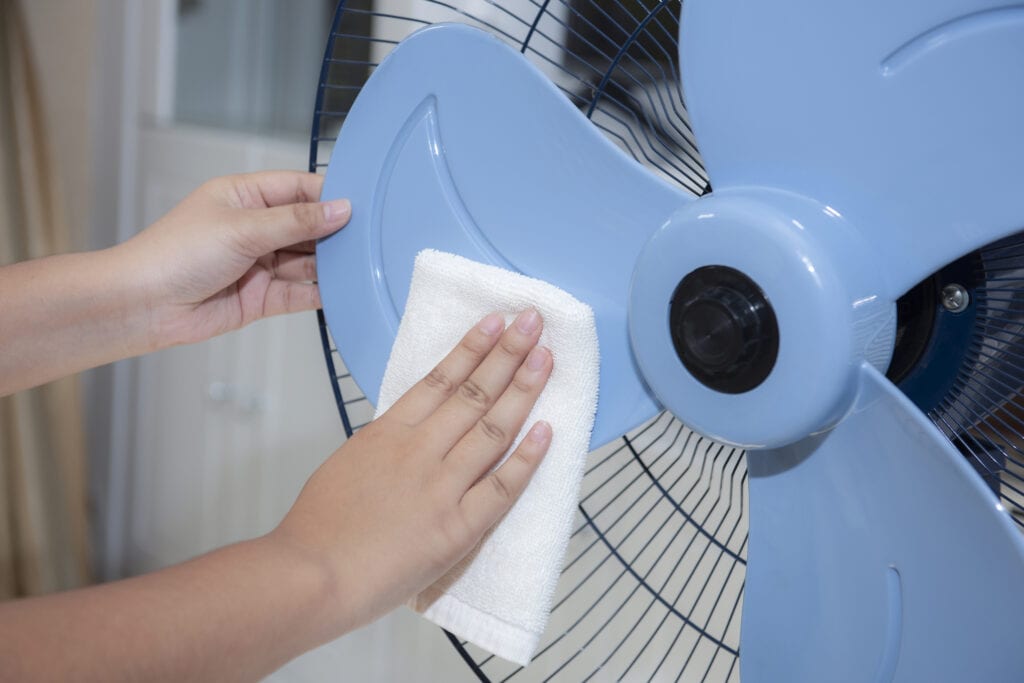
● First, unplug the unit completely.
● Remove the front grill to allow access to the unit. This will likely require you to remove a few screws.
● Wipe down the inner cavity and all fan blades. Do this gently to avoid bending or damaging the angle of the blades.
● Use canned air or a hairdryer to blow out any dust from between the blades or within the motor housing. Do this from both the front and the back.
● If the unit is still dirty, use a clean cloth dipped in a mixture of all-purpose cleaner to wipe clean any dirt. Use caution to keep liquid from getting inside any electrical components.
Cleaning a Ceiling Fan
● Ceiling fans aren’t difficult to clean either but they can be difficult to access. For this, you will need a ladder. You also may want to wear a face mask as many airborne allergens will be present in the dust that has accumulated.
● Remove all dust from the blades. Use caution not to pull on or damage the blades. You can use a vacuum attachment or pillowcase for this.
● Check and tighten any loosened screws.
● Vacuum any visible areas of the fan motor to remove dust that has gotten inside.
● Check your owner’s manual to see if your ceiling fan needs to be oiled. This type will have a small oil reservoir with a small hole for adding oil. Add a few drops regularly to ensure your fan operates properly.

How Often Should I Clean a Fan?
No matter what type, your fans should be cleaned regularly. When in use regularly, you should clean these at least once per month. They should also be cleaned before and after seasonal usage. If you notice any dust or dirt buildup, this is also a sign that it is time to clean your fan, even if sooner than recommended.
When is it Time to Replace My Fan?
Depending on the type of fan, it may last a few years or up to twenty years with proper maintenance. Ceiling fans are on the upper end of this range. Lower quality ones may only last up to five years though. Here are some signs your fan (ceiling or otherwise) needs to be replaced.
Signs It’s Time To Replace Your Fan
Your Fan Is Making Strange Noises
If your fan is suddenly loud, clicking, or rattling and troubleshooting hasn’t resolved the issue, you likely need to replace it.
Change in Style or Decor
If your fan no longer complements your decor, you should consider a more modern or stylish option.
Not Moving Enough Air
This can be due to an improperly sized fan or a fan that isn’t operating as well as it should.
Your Fan Is Shaking
If you can’t tell if there’s an earthquake because your fan shakes so much anyway, AND you’ve tried the troubleshooting steps above, you should probably get a new fan.
Anytime your fan isn’t living up to your needs and expectations, you can consider a replacement. Room fans are fairly inexpensive and easy to use. Ceiling fans are a little higher priced but still affordable overall. Either way, a newer, more efficient fan will improve the feel of your home all year long.
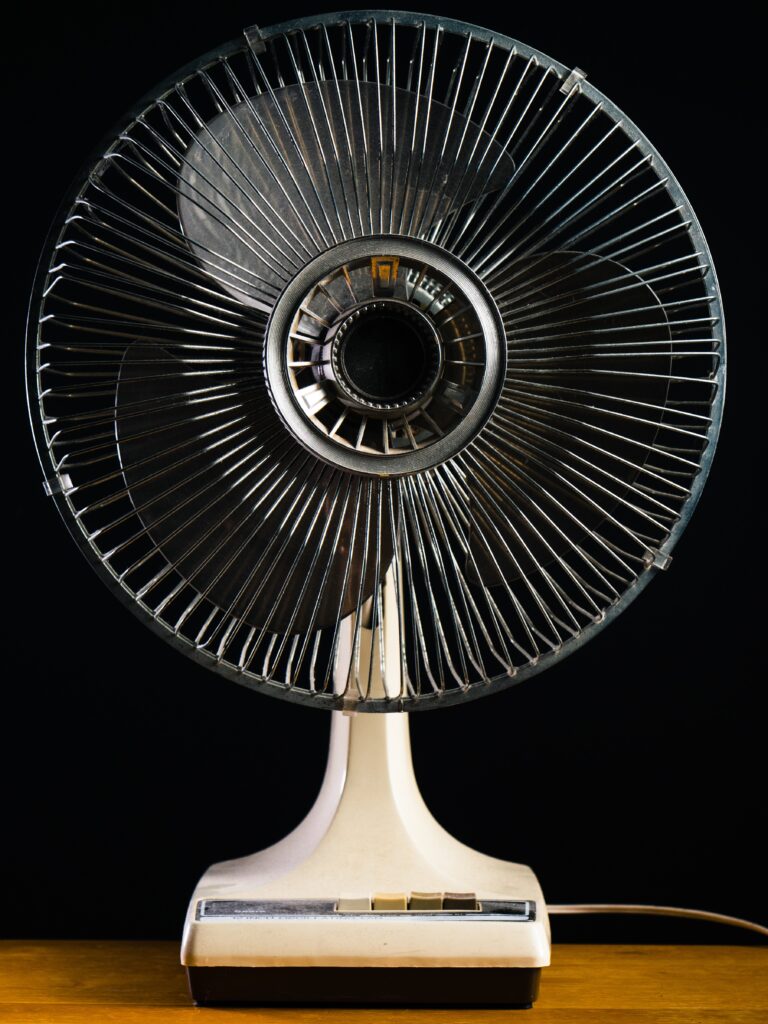
Can You Really Find a Quality Fan That’s Affordable?
Yes, there are high-quality fans out there for any budget. First, you need to determine how much you are willing to spend and the type and performance you expect. If you only need cooling for a small area, tailor your choices to that alone. Bigger isn’t always necessary.
Once you know what you want, it will be easy to filter through the options available. Be sure to read reviews so you get a product you’ll love and will live up to its promises.
Conclusion
There is a fan for every person out there. Whether you need a fan to cool your garage, one with a remote, or even one that cools like an air conditioner, you can find what you are looking for.
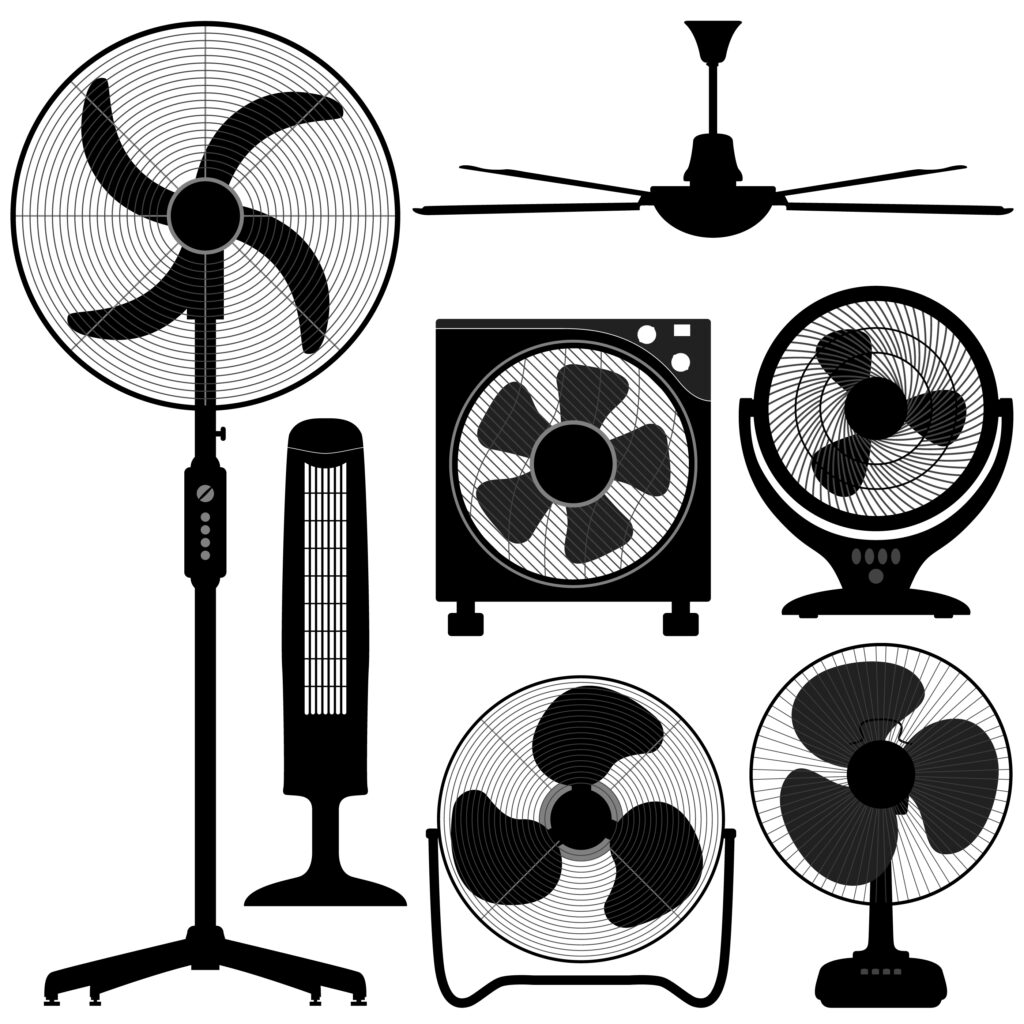
Use the helpful information above to give you an idea of what you want and how to start. Then you’ll be on the road to a cooler, more comfortable home. Thanks for checking out our article!
